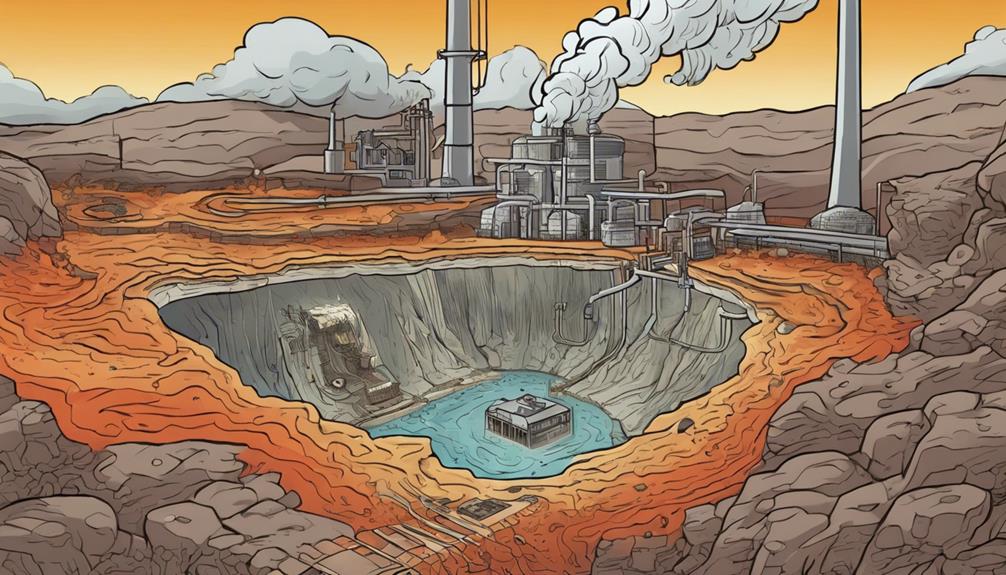To master lawn aeration in 7 days, start by understanding its benefits, like improving soil health and encouraging strong roots. Identify signs that your lawn needs aeration, such as compacted soil or patchy spots. Choose the right equipment—core or spike aerators—and prepare your lawn by watering thoroughly. Follow step-by-step instructions to aerate properly and care for your lawn afterward. Keep improving your technique and maintenance skills, and you’ll turn your yard into a vibrant, healthy space.
Key Takeaways
- Understand the signs indicating your lawn needs aeration, such as compacted soil or poor grass growth.
- Learn proper preparation steps, including watering and debris removal, before using a core or spike aerator.
- Choose the right aeration equipment based on your lawn size and soil condition, and maintain it regularly.
- Follow post-aeration care like light fertilization, thorough watering, and avoiding foot traffic to ensure optimal recovery.
- Incorporate ongoing lawn maintenance practices, including overseeding, proper mowing, and soil health monitoring, to master aeration success.
Understanding the Benefits of Lawn Aeration
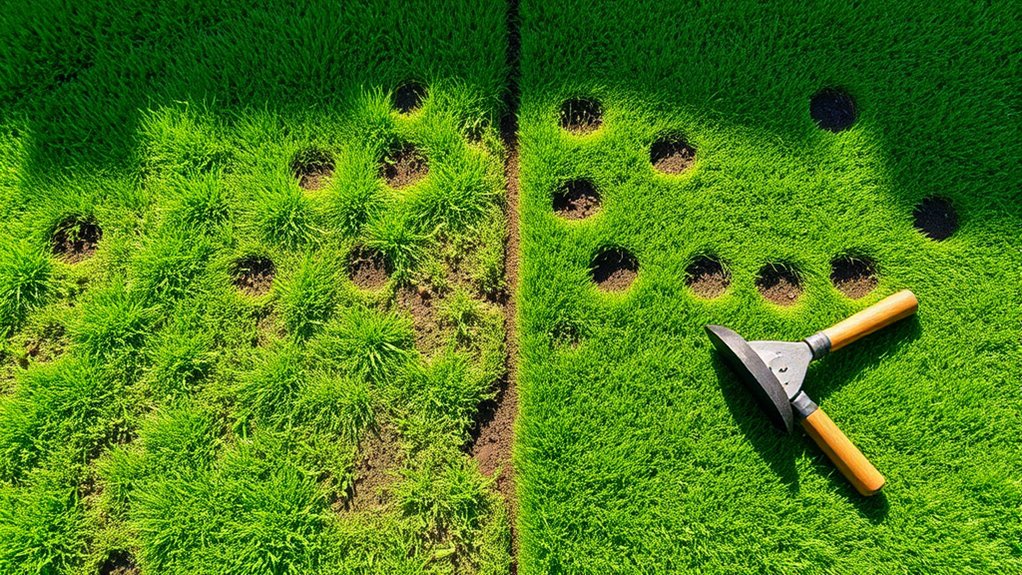
Have you ever wondered why lawn aeration makes such a difference? It’s because aeration reduces soil compaction, allowing your grass roots to breathe and grow more effectively. When soil becomes compacted, it becomes dense and hard, making it difficult for roots to access water, nutrients, and oxygen. This stress weakens your lawn’s overall health and resilience. By aerating, you create small holes that loosen the soil, promoting better root development and stronger root systems. This improved root health results in a thicker, greener lawn that can withstand drought, pests, and foot traffic. Aeration also enhances water absorption and nutrient uptake, ensuring your grass gets everything it needs to thrive. In short, aeration is essential for a healthier, more vigorous lawn.
Assessing When Your Lawn Needs Aeration

You’ll notice your lawn isn’t looking its best when the soil feels hard or dense underfoot. If your grass appears patchy or struggles to grow, it might be a sign that the soil is compacted. Keep an eye on these changes, as they indicate it’s time to contemplate aeration to help your lawn thrive. Additionally, using proper lawn aeration techniques can significantly improve soil health and promote healthier grass growth.
Signs of Compacted Soil
How can you tell if your lawn’s soil has become compacted? One clear sign is increased soil density, making it harder for water, air, and nutrients to penetrate. You might notice that your grass feels hard underfoot or resists pulling up a small plug of soil. Root restriction is another indicator—if roots are shallow, tangled, or appear to struggle, the soil may be too compressed to support healthy growth. You may also observe that your lawn isn’t responding well to watering or fertilizing, with poor drainage or water runoff. These signs point to soil that’s become dense over time, limiting root expansion and overall vitality. Addressing soil compaction through aeration can restore proper airflow, encouraging healthier roots and a more vibrant lawn.
Lawn Appearance Changes
Changes in your lawn’s appearance can be clear signs that it’s time to contemplate aeration. If your grass looks dull or patchy, it’s often due to poor lawn color improvement caused by compacted soil restricting airflow and nutrients. Additionally, if your grass feels spongy or resistant when you walk across it, it indicates that the soil is too dense for healthy grass root development. You may also notice areas where water pools or drains slowly, signaling that the soil isn’t absorbing moisture properly. These visual cues suggest that aeration can help loosen the soil, promote better grass root development, and enhance overall lawn health. Moreover, neglecting issues like cheating behaviors in your lawn care routine, such as ignoring soil compaction, can lead to long-term damage and further deterioration. Addressing these appearance changes promptly ensures your lawn remains lush, vibrant, and resilient.
Choosing the Right Aeration Equipment
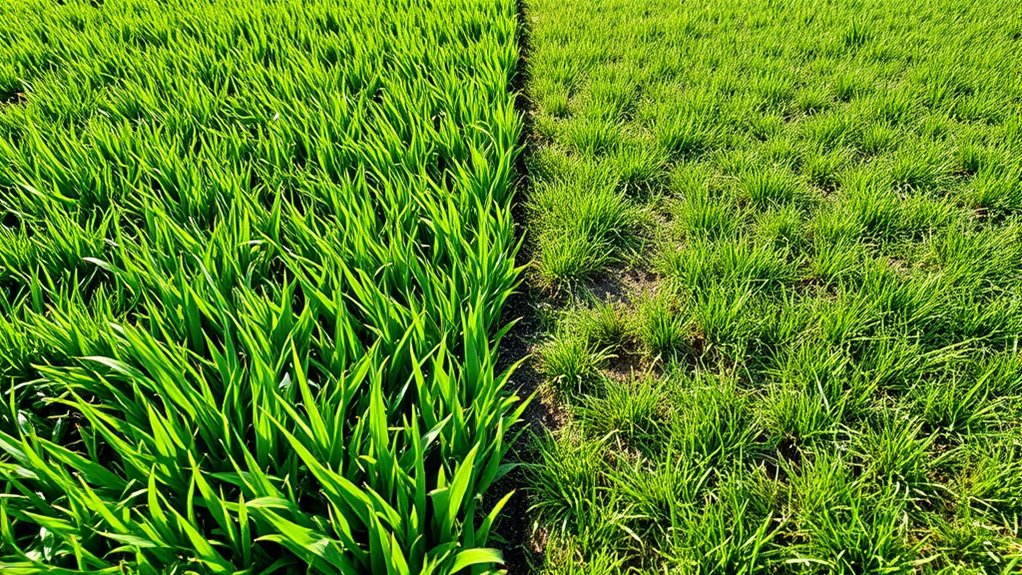
Choosing the right aeration equipment depends on your lawn size and soil condition. You’ll need to decide between different types of aerators and whether to use power tools or manual options. Proper upkeep guarantees your equipment stays effective and lasts longer. Additionally, selecting equipment with high-quality components ensures durability and consistent performance.
Types of Aerators
Are you aware that different types of aerators serve distinct purposes and suit various lawn conditions? Knowing whether to use core aeration or spike aerators can make a big difference in your lawn’s health. Core aeration removes plugs of soil, reducing compaction and promoting root growth, ideal for heavily compacted lawns. Spike aerators, on the other hand, poke holes into the soil without removing material, which works for light aeration needs. When choosing equipment, consider your lawn’s size and soil condition. Glycolic acid can help improve soil health and support a thriving lawn environment when used appropriately. Here are some options to contemplate:
- Core aerators for deeper soil relief
- Spike aerators for quick, light aeration
- Manual or power options depending on your effort level
Selecting the right aerator helps you achieve a lush, healthy lawn in less time.
Power vs. Manual Tools
When selecting aeration equipment, you’ll need to decide between power tools and manual tools based on your lawn’s size, soil conditions, and how much effort you’re willing to invest. Power tools, like motorized aerators, are ideal for large lawns or compacted soil. They save time and effort, making the process quicker and less strenuous. Manual equipment, such as hand-held spike or plug aerators, work well for small lawns or light aeration needs. They’re affordable, portable, and require no power source. However, they demand more physical effort and take longer to cover the same area. Consider your lawn’s size and your physical capabilities when choosing between power tools and manual equipment. Picking the right tool guarantees efficient aeration without unnecessary fatigue.
Equipment Maintenance Tips
To guarantee your aeration equipment performs effectively and lasts longer, regular maintenance is essential. Proper upkeep assures smooth operation and a healthier lawn. When choosing the right equipment, consider factors like size, ease of use, and compatibility with your lawn’s needs. After each session, clean the tines or blades to prevent rust and debris buildup. Sharpen blades regularly for clean holes and fewer turf tears. Store equipment in a dry, protected area to avoid rust. Remember to apply lawn fertilizer after aeration to promote growth, and prune nearby plants to prevent obstruction. Additionally, inspect for loose parts and lubricate moving components. Proper maintenance not only extends equipment life but also improves aeration quality, helping your lawn stay lush and healthy. Incorporating biodiversity-friendly practices during lawn care can further enhance your yard’s ecosystem and support local wildlife.
Preparing Your Lawn for Aeration
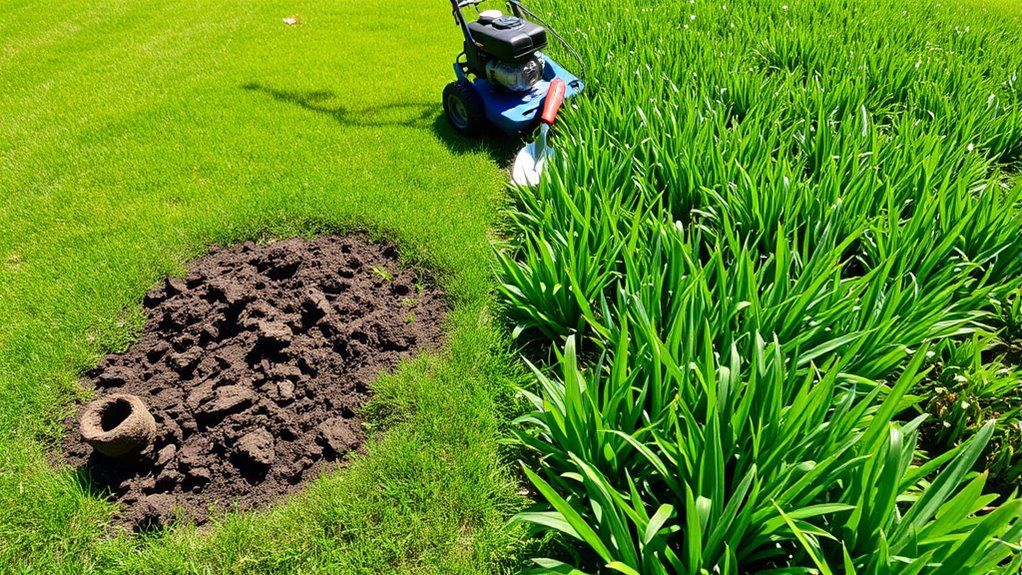
Before you aerate your lawn, it’s important to prepare the turf to guarantee the process is effective and minimizes stress on the grass. Start by ensuring proper soil preparation: loosen compacted soil and remove debris like rocks or sticks. Water your lawn thoroughly a day or two before aeration—lawn watering softens the soil, making aeration easier and more effective. Avoid fertilizing immediately beforehand, as it can interfere with soil penetration. Proper soil preparation is also essential to understand the city dynamics that may affect your yard’s drainage and soil quality.
Step-by-Step Guide to Aerating Your Lawn
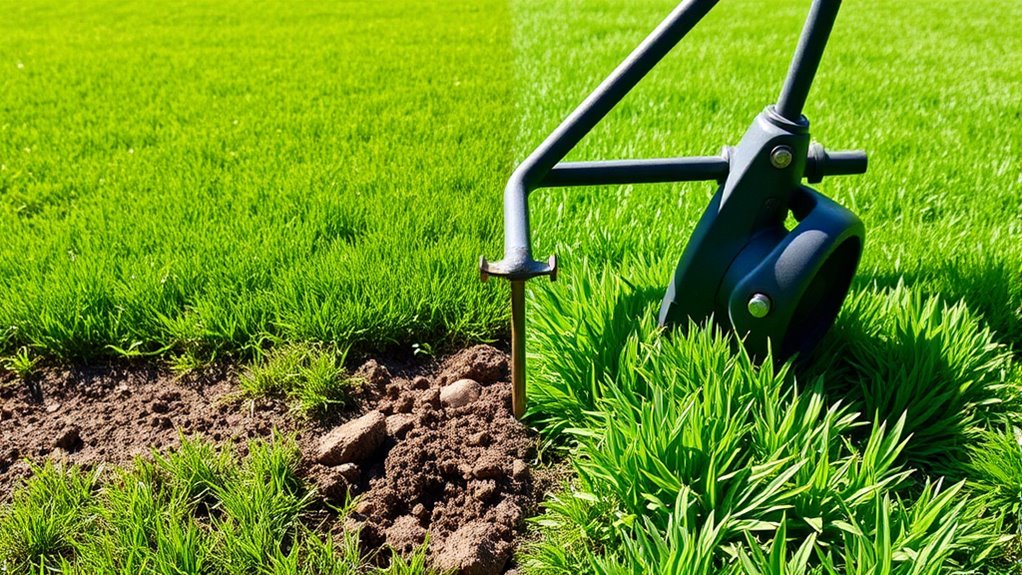
Aerating your lawn is a straightforward process that considerably improves soil health and root growth. To begin, choose the right time—preferably during active growing seasons. Using a core aerator, systematically work across your lawn, making passes in different directions to break up soil compaction.
Remember these key steps:
- Focus on areas with dense soil or heavy foot traffic to improve air flow.
- Adjust the aerator’s depth for ideal soil penetration, typically 2-3 inches.
- Leave the cores on your lawn; they’ll break down naturally, enhancing soil structure.
This process encourages better root development by alleviating soil compaction, ensuring your grass roots have space to grow and access nutrients effectively.
Post-Aeration Care and Maintenance
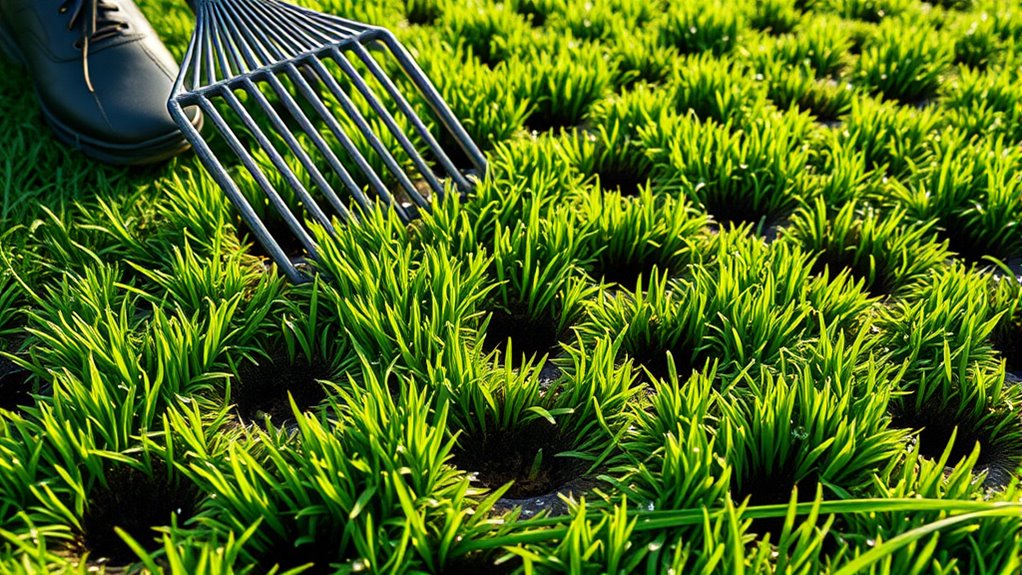
After you finish aerating, providing your lawn with proper care is vital to maximize the benefits. To improve soil health and support grass recovery, give your lawn a light fertilization and water it thoroughly. Avoid heavy foot traffic for a few days to let roots stabilize. Mulching or overseeding can also help fill patches and boost growth. Keep an eye on soil moisture levels—too dry or too wet can hinder recovery. Regularly inspect your lawn for signs of stress or compaction, and adjust your care accordingly. Here’s a quick overview:
| Action | Benefits | Timing |
|---|---|---|
| Light fertilization | Promotes grass recovery | Immediately after aeration |
| Proper watering | Enhances soil health | Within 24 hours |
| Avoid foot traffic | Prevents soil compaction | 3-5 days post-aeration |
| Overseeding | Fills patches, improves turf | 1-2 weeks after aeration |
| Monitor soil moisture | Supports healthy grass growth | Weekly |
A key to successful recovery is understanding how soil health affects grass growth and resilience.
Tips for Maintaining a Healthy, Vibrant Lawn
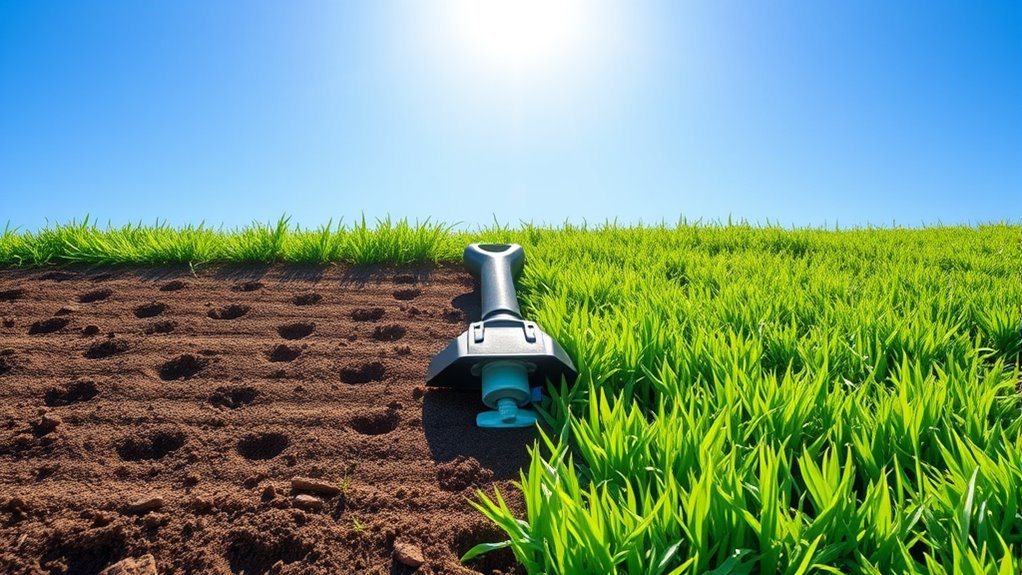
Maintaining a healthy, vibrant lawn requires consistent effort and smart practices. To do this effectively, focus on proper gardening techniques and pest control strategies. Regularly mow at the right height to promote root growth and avoid stressing your grass. Water deeply and infrequently to encourage strong roots, especially after aeration. Additionally, monitor for pests and apply appropriate pest control methods to prevent damage. Incorporating emotional support for yourself during lawn care routines can also help maintain motivation and reduce stress.
Consistently mow, water deeply, and monitor pests for a healthy, vibrant lawn.
To enjoy a lush lawn, consider these tips:
- Use targeted gardening techniques like overseeding and fertilizing at ideal times
- Implement integrated pest control to manage pests without harming beneficial insects
- Aerate annually to improve soil health and nutrient absorption
Frequently Asked Questions
Can Lawn Aeration Be Done During Rainy Seasons?
Yes, you can do lawn aeration during the rainy season, but it’s not ideal. Rainy weather softens soil, making aeration easier and more effective, especially for relieving soil compaction. However, avoid aerating when the soil is too muddy or waterlogged, as it can lead to uneven holes and damage your lawn. Wait for a period of consistent, moderate rain or dry days to get the best results.
How Often Should I Aerate My Lawn Annually?
You should aerate your lawn 1 to 2 times a year to prevent soil compaction and promote healthy root growth. Coincidentally, this timing often aligns with seasonal changes when your soil naturally becomes denser. Regular aeration loosens compacted soil, allowing roots to access nutrients and water more efficiently. If you notice poor drainage or thin grass, consider aerating more frequently to keep your lawn vibrant and resilient.
Is Professional Aeration Better Than DIY Methods?
Professional aeration is usually better because it uses advanced aeration equipment that effectively relieves soil compaction. When you hire experts, they ensure thorough coverage and proper techniques, reducing the risk of damaging your lawn. DIY methods often lack the equipment needed for deep, uniform aeration, which can lead to incomplete soil aeration. Investing in professional services helps your lawn breathe better, grow healthier, and stay lush longer.
What Are Common Mistakes to Avoid During Aeration?
You should avoid common mistakes like over-aerating, which can cause soil compaction issues, or aerating when the soil is too wet, leading to poor seed germination. Don’t forget to mark sprinkler heads and underground utilities to prevent damage. Additionally, skipping proper equipment maintenance or neglecting to follow soil testing recommendations can hinder aeration benefits. Stay mindful of these pitfalls to make sure your lawn thrives after aeration.
How Does Aeration Impact Lawn Pest Control?
Aeration improves pest control by reducing soil compaction, which allows roots to breathe and grow stronger. When the soil is less compacted, beneficial insects and microbes thrive, helping naturally suppress pests. You’ll notice healthier roots that can resist infestations better. By aerating, you create an environment where pests are less likely to establish and spread, leading to a healthier, pest-resistant lawn.
Conclusion
By embracing lawn aeration, you’re gently opening the door to a healthier, more resilient yard. With patience and care, you’ll nurture your lawn’s natural strength, allowing it to flourish quietly beneath the surface. Remember, even the most vibrant gardens grow best when given the right conditions to breathe and expand. Keep tending with dedication, and your lush, thriving lawn will quietly reward your efforts, revealing its true beauty over time.



